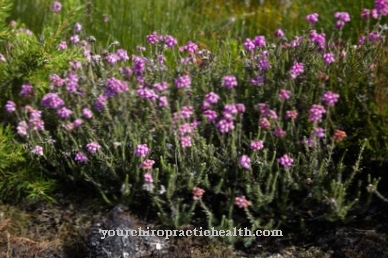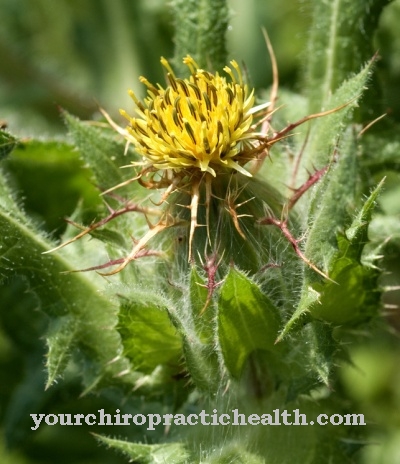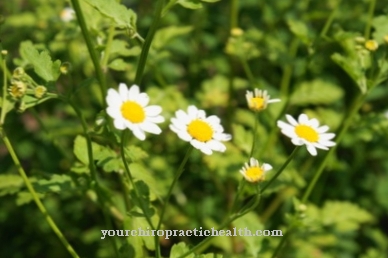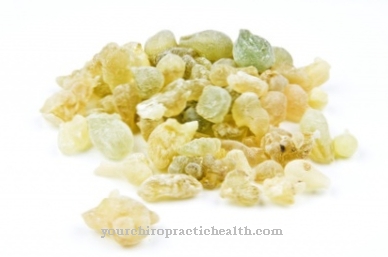Galbanum was already a popular smoking resin in ancient Mesopotamia. The health-promoting effect of the plant Ferula erubescens was described in detail by the Greek doctor and pharmacologist Pedanios Dioskurides in the 1st century AD. The Middle Ages also valued their medicinal properties.
Occurrence & cultivation of the galbanum
Galbanum (Ferula erubescens, Ferula gummosa) is a perennial herbaceous plant belonging to the umbelliferae family (Apiaceae) and is also known as giant fennel. The medicinal plant is found in the Mediterranean countries and even in Central Asia. Most Galbanum species, however, are native to Southwest Asia and Central Asia. The old medicinal plant forms woody tap roots and has branched stems.Their alternate leaves are pinnate two to four times. It sprouts double-gold inflorescences with a multitude of yellow five-fold flowers. Then elliptically shaped double achene fruits with lateral wings develop.They are filled with flat concave seeds. To extract the white milk juice, the root is dug up and cut so that the thick juice can run out. The lower section of the stem also contains juice, which is used to obtain galbanum resin and galbanum oil.
Effect & application
Galban resin is made from the dried milky juice of the Iranian galbanum. The galbanum plant required for this grows in Iran, Afghanistan and in the east of the Aral Sea. The leaking juice dries very quickly in the air and forms a soft, tough and sticky mass.
This has different color tones depending on its chemical composition: There are transparent, white, greenish, yellowish and brownish galbanum resin. It contains about 20 percent gum and a maximum of six percent essential galbanum oil (Oleum galbani). Galban resin smells like spruce needles and has a heavy, sweet, balsamic aroma.
Its taste is described as hot and bitter. It is exposed to cold to pulverize. To obtain the valuable oil, the resin is steam distilled. One liter of oleum galbani can be made from around six kilograms of resin. The oil is usually colorless, but under the influence of oxygen it takes on a brownish color and also thickens quickly.
Galbanum oil has a bitter, camphor-like taste and an intense grassy odor. In natural medicine, the purified and powdered resin and the galbanum oil are traditionally used internally and externally to treat various diseases and complaints.
The active ingredients contained in it have an emollient, menstruation-promoting, antiseptic, circulatory and immune-strengthening, blood circulation-promoting, pain-relieving, spasmodic and expectorant effect. The fragrant oil is also widely used in aromatherapy. It soothes irritable and restless minds, improves the mood and internally balances out when the person is agitated and worried.
Nowadays, galbanum is also used to fix scents in perfume production and as a flavor enhancer in food. It is part of various smoking mixtures and is mainly used in high-quality oils and soaps because of its woody, intensely spicy scent. To round off the scent note, it is often combined with vetiver or neroli.
Importance for health, treatment & prevention
Galbanum resin contains the following ingredients: monoterpenes (70 percent), monoterpenols, sesquiterpenes, sesquiterpenols, aldehydes, phenyl ethers, esters, ketones and other chemical substances. Resin and oil from Ferula erubescens are versatile in natural medicine. In the past, gynecological problems such as menstrual disorders were cured with galbanum suppositories and incense.
Galbanum is still used today in Iran to regulate menstrual bleeding. Dead fetuses could be aborted using a mixture of myrrh, wine, and galbanum. Due to its frequent use for abdominal complaints, the vernacular gave the resin from the giant fennel species the name "mother resin".
An external application of galbanum, baking soda and vinegar helped against unsightly moles. In the case of a toothache, the patient simply stuck a piece of galbanum into the destroyed tooth. Many of the proven applications live on in traditional Iranian folk medicine and are also used in naturopathy in this country.
With a drop of pure galbanum oil, large boils can be shrunk and purulent acne pimples disinfected so that they soon dry out. However, the monoterpenes, the most important ingredient in galbanum oil, create intense skin stimuli and can trigger skin irritations in higher doses. Therefore, patients with sensitive skin should only apply galbanum oil dissolved in a base oil or in mixtures with other essential oils.
Galbanum oil is drunk to treat coughs and respiratory diseases associated with shortness of breath. The active ingredients dissolve bronchial mucus and so alleviate bronchitis and bronchial asthma. When used internally, they also help with colds, digestive problems and strengthen the immune system.
Because of its circulatory, pain-relieving and warming properties, the patient can also use galbanum to treat sore muscles, muscle tension and cramps. Since the Galbanum ingredients also have an antispasmodic effect, the oil was often used to treat epilepsy.
If you want to use Oleum galbani internally, drizzle up to four drops on a teaspoon of honey twice a day. Then dissolve the whole thing in a glass of lukewarm herbal tea or water. Externally, galbanum oil helps in the form of washes and compresses for abscesses and acne and as a rub against rheumatic diseases.
Galbanum oil has also proven itself in the field of skin care. It is used not only for skin damaged by acne, but also to apply cream to dry, sagging and wrinkled skin. It is only dosed in small amounts. The patient gives a drop of oleum galbani to 50 ml of the base oil.
























.jpg)



